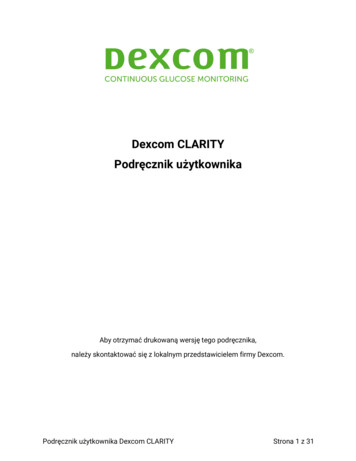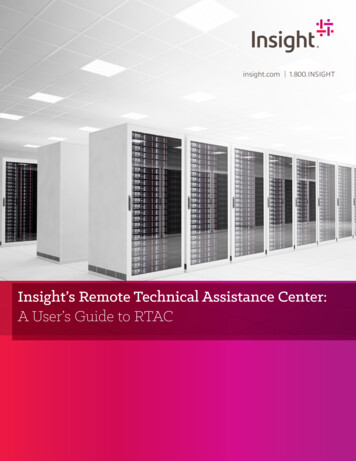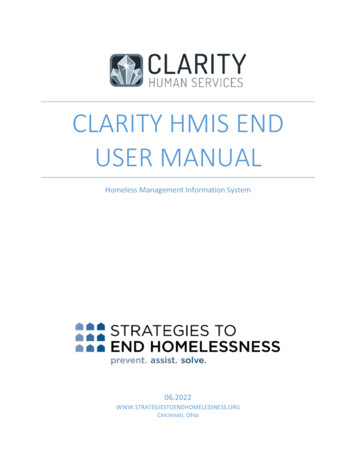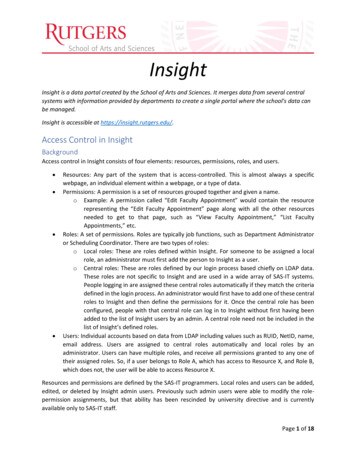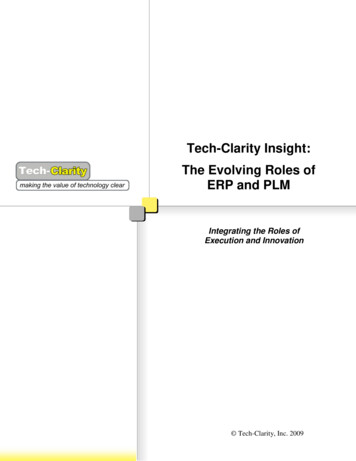
Transcription
Tech-Clarity Insight:The Evolving Roles ofERP and PLMIntegrating the Roles ofExecution and Innovation Tech-Clarity, Inc. 2009
Table of ContentsExecutive Overview . 3Defining the Roles of ERP and PLM . 4Where does PLM Stop, and ERP Begin? . 6Roles: The Technical Perspective. 9Integrating Innovation to Execution . 9Evolution: Bi-Directional Integration . 11Further Evolution: Advanced Integration . 11Integration: The Technical Perspective . 13Conclusion . 14Recommendations . 15About the Author . 152 Tech-Clarity, Inc. 2009
Executive OverviewERP and PLM are two of the most significant components in the enterprise systemsecosystem for manufacturers. Tech-Clarity research report “The Complementary Roles ofERP and PLM” indicates that ERP and PLM play important, distinct, and complementaryroles in helping companies achieve product profitability. PLM plays the primary role inproduct innovation, product development, and engineering while ERP plays the primaryrole in planning and managing business execution. Of course ERP also plays otherimportant non-product-related roles in accounting, corporate governance, and humanasset management. As companies have matured the use of these systems, integrating thetwo solutions and ensuring they work in harmony has increased in importance.Until recently, however, research has shown that most companies have limitedintegration between these systems. As PLM has matured and companies have used it forlonger periods of time, the view towards integrating ERP and PLM has also matured. Therole each system plays has remained the same – PLM for managing innovation and ERPfor managing business execution – but the integration between them has evolvedsignificantly. This is the result of the continued extension of PLM beyond the engineeringdepartment and into the enterprise, including the incorporation of more advancedproduct-related processes in domains such as product compliance, direct materialssourcing, design for cost, and quality planning. Each of these processes has a corollary inboth ERP and PLM, with PLM typically taking the lead in designing the approach andERP taking the lead in putting the strategy into operation and reporting actual results.The role each system plays has remained the same –PLM for managing innovation and ERP for planning and managing execution– but the integration between them has evolved significantly.Although this two-system ecosystem is a good generalization for the purposes of thispaper, it’s important to recognize that real-time execution of these processes is frequentlyfound in more detail-oriented, real-time systems such as Manufacturing ExecutionsSystems (MES), Quality Management Systems (QMS), Supply Chain ManagementSystems (SCM) and Asset Lifecycle Management (ALM, also known as MRO systems).The report concludes that manufacturers can take an evolutionary approach to achieve anintegrated ecosystem of solutions that spans product innovation, product development,engineering, manufacturing, and support. Regardless of where a company starts with ERPor PLM, their evolution can include the maturation and greater use of each of thesesystems in parallel with greater integration of the systems to close the loop betweeninnovation and execution cycles. The clear result is that each solution provides value in aunique way to the manufacturing community, and that the combination of the two offerseven greater value.3 Tech-Clarity, Inc. 2009
Defining the Roles of ERP and PLMTech-Clarity has researched the roles of ERP and PLM in manufacturing before. The firstreport, “The Complementary Roles of ERP and PLM - Leveraging EnterpriseApplications to Maximize Product Profitability” explored the roles of each of thesystems. A follow-up study by Aberdeen Group, “Enabling Product Innovation:The Roles of ERP and PLM in the Product Lifecycle” confirmed many of the findingswith a benchmark survey. The key finding of these reports was that ERP and PLMprovide fundamentally different value based on the strategic focus of each. Although thelines between the systems sometimes appear blurry, there are distinct characteristics andrequirements for each, and each has their own strengths.Since these reports were published, manufacturers have made a lot of progressimplementing and using PLM. During this time, the use of PLM has maturedconsiderably, expanding to cover more product-related processes, product information,people, and lifecycle segments. This report updates these perspectives, although therelative roles of ERP and PLM have not changed significantly. Each of these systems hascertain “themes” and “focuses” that they are strong in. The power of ERP includesmanaging orders and centralizing control and accounting. As an example, Cameronmanufactures flow equipment products for the oil and gas and process industries. GregObets, the Manager Engineering Systems at Cameron describes the role of ERP in hiscompany. “ERP is largely where the finances are, it’s what runs the company, everythingabout the business is kept there.” The power of PLM, on the other hand, includes themesof managing product knowledge, enhancing speed to market, and collaboration.ERP is fantastic at executing transactions,but the design and collaborative space are not strengths.Tano Maenza, Director of Business Solutions, EmersonBoth ERP and PLM play a very important, but distinct role in driving productprofitability. They were designed for different business processes, and have evolved tobetter support the needs of those processes. Tano Maenza, the Director of BusinessSolutions for diversified global manufacturer Emerson, explains that each system hasstrengths and weaknesses. “ERP is fantastic at executing transactions, but the design andcollaborative space are not strengths,” Mr. Maenza explained. Cameron’s Greg Obetsdiscusses how these strengths impact where they use each system. “We use our ERPcompany’s PLM for document control, but we are moving away from that. Revisioningand document control are in ERP, but it is all manual and we rekey a lot of stuff. It alsowon’t manage CAD files. We are moving document control into PLM and then pushinginto ERP for non-engineers.”4 Tech-Clarity, Inc. 2009
The following table (Figure 1) helps underscore the differences in ERP and PLM. Thetable was originally published by Tech-Clarity in 2004, and has been updated to reflectthe maturation of both the roles of PLM and the relationship with ERP:ERPPLMExecution FocusedInnovation FocusedRepeated TransactionsCreating, Designing, Iterating andRevisingSteady StateManages and Promotes ChangeInventory / Order LifecyclesProduct LifecyclesControlled, Well-Defined BusinessProcessesDisciplined, but Flexible DesignProcessesSimple BOM HierarchyComplex Design Relationships, SystemsView (Mechanical, Electrical, andSoftware)BOM to Procured Part / AssemblyLevelFull Product Structure to Component orRaw Material LevelReleased VersionsProduct Iterations, Revisions andDecision HistoryCentral Theme of ControlCentral Themes of Speed and ManagedCreativityOrder / Supply / Demand FocusedDesign / Requirements / Configuration /Project / Program FocusedRigid Data ModelFlexible Data StructureStructured DataDocuments, Structured and UnstructuredInformation, MetadataHierarchical Data RelationshipsDynamically Related, Networked DataRelationshipsData MiningKnowledge Search and Retrieval,Geometric SearchText-based with some static 2D and3D ImagesVisual, 3D Models, Simulation,AnimationFigure 1: Comparing the Characteristics of ERP and PLM5 Tech-Clarity, Inc. 2009
ERP and PLM serve very different needs, and have different requirements. For example,ERP requires a bill of material (BOM) at a level required to plan and account forproduction. Therefore, a purchased assembly may have all of its parts designed anddocumented in PLM, but be summarized into ERP simply as a purchased part. This isparticularly true for electronic parts, where an electrical design that includes all of theindividual mechanical and physical components is likely to be incorporated into ERP as apurchased board. This information is a level of detail acceptable for materials planning,but falls short when detail is required for activities like compliance analysis, costing,quality, or parts reuse.ERP requires a BOM at a level required to plan and account for production a level of detail acceptable for materials planning, but falls short when detail isrequired for activities like compliance analysis, costing, quality, or parts reuse.“If you just want to manage a BOM, ERP is OK. But integrating CAD, documentmanagement, viewing and markup, collaboration and workflow configuration is veryhelpful, not to mention engineering BOM to manufacturing BOM planning, visualization,and process simulation – ERP is just not there,” Emerson’s Tano Maenza explains. Thelevel of detail required in ERP is simply different. This is even more so for mechatronicsparts where companies are modeling the entire mechanical, electrical, and softwaresystem together.Where does PLM Stop, and ERP Begin?With clearly different roles for ERP and PLM, the question then becomes which solutionto use for which needs. When asked, most manufacturers see a clear handoff pointbetween PLM and ERP. This was further supported by the survey research conducted byAberdeen Group. This handoff point is typically “release to manufacturing,” althoughsome companies have matured from there a bit in their integration. For example,companies have extended the use of PLM beyond release to manufacturing to manage asbuilt and as-maintained configurations. Others have extended the integration to earlierphases in product development. “In our new product development (NPD) process, weexpose the product to our ERP system after our preliminary design phase-gate to supportforecasting and pricing,” explains Emerson’s Tano Maenza. “Then, after detailed designwe have our formal release.”Most manufacturers see a clear handoff point between PLM and ERP typically “release to manufacturing.”One way to think of the roles of ERP and PLM is that PLM determines what the productshould be, and ERP helps manage the business of turning that vision into real products.6 Tech-Clarity, Inc. 2009
Again, it’s important to recognize that the detailed execution is often found in solutionssuch as MES, SCM, or ALM/MRO. PLM has also evolved to other aspects of theproduct, such as regulatory or customer compliance, quality and safety, manufacturingplanning, and costing. But what remains consistent is that PLM focuses on defining theintent of the product – both technically and commercially. ERP then helps planproduction resources at a high level, accounts for material usage, plans inventory,manages orders, and accounts for the physical delivery of the product. In essence, PLM isthe innovation cycle and ERP is the backbone for the execution cycle (Figure 2), withERP serving as the backbone for execution, and with execution details integrated in frommore detail-oriented, real-time systems or manual processes. This graphic was originallypublished by Tech-Clarity in 2004, and has been updated to reflect the maturation of boththe roles of PLM and the relationship to ERP.Figure 2: Manufacturing Systems EcosystemThe innovation cycle is characterized by rapid iteration and revisions, while the executioncycle is- characterized by a more linear, repeatable processes. Much of the information inthe innovation cycle, including work-in-progress designs and plans, are not formallycaptured and shared without PLM. This information does not have a home in ERP, and istypically found in unmanaged documents and spreadsheets.7 Tech-Clarity, Inc. 2009
“A lot of data never makes it to ERP, and historically we would lose it,” says Cameron’sGreg Obets, “All of that data is what we were so concerned about, we lost it way toooften. But PLM was born for work-in-process designs and products.” Design iterationsand other product development information are considered clutter in an executionoriented system such as ERP, but this intellectual property (IP) stored in PLM representsa valuable corporate asset.The graphic also includes more advanced integration concepts, including bi-directionalintegration of information and more advanced integration from ERP to PLM to reflect theevolving, maturing roles of ERP and PLM. These more advanced integration concepts area direct result of expanding PLM to encompass more product-related processes. Thefollowing table reflects the roles that ERP and PLM in these advanced integrationdomains including quality, costing, compliance, manufacturing, maintenance, and directmaterial sourcing.ERPPLMQuality Specifications, Quality Data,Inspection PlansQuality Plans, FMEA, RiskManagement, Predictive QualityAccount for Cost Performance /Variances, Enterprise-wide CostAnalyticsOptimize As-Designed CostCompliance CertificationCompliance Validation, SupplierCollaboration, Bill of Substance, etc.Routing at Operation, WorkcenterLevel for PlanningBill of Process, Work InstructionsMaintenance Transactions,Contractual Agreements, MaterialsMaintenance Plans, Procedures,Resource Requirements, As MaintainedManaging Manufacturing OperationsOptimizing Production Model,Manufacturing Engineering, SimulationPurchasing Transactions, Orders,HistoryDirect Material Sourcing, SupplierSelectionFigure 3: Advanced Roles of ERP and PLM8 Tech-Clarity, Inc. 2009
Roles: The Technical PerspectiveSo far the discussion has been primarily about the functional roles that ERP and PLMplay and the resulting functional differences. It is important to understand that thesedifferences in purpose have also driven the way that the respective systems architectureshave evolved. The following are some considerations when determining the differencesin technical requirements between PLM and ERP. As mentioned earlier, much of the datain PLM is clutter to ERP, including revisions that have not been released to production.These unreleased products and revisions carry valuable product knowledge, but arebaggage – and potential for mistaken usage – in an execution management system likeERP.Mathias Mond is the CEO of a systems integrator with special focus on ERP-PLMintegration, whose company is partnered with leading PLM and ERP companies. Mr.Mond provides his perspective on product data size as technology driver. “You have toconsider the amount of data that needs to be handled in product development, wheremuch of the data has nothing to do with the operation of the company. Most of it is onlyrelevant to engineering, for example, to go back to a dead end to understand why adecision was taken. That information doesn’t have a place in ERP and there it would behard to get any value out of it, but it is very valuable in PLM.”You have to consider the amount of data that needs to be handled in productdevelopment that information doesn’t have a place in ERP and there itwould be hard to get any value out of it, but it is very valuable in PLM.Mathias Mond, CEO, Systems Integrator / ERP and PLM PartnerDesign iterations are a key consideration to the amount of data in PLM. Anotherimportant aspect is that each revision in PLM may include all of the related analysis,design, graphics, documentation, and other information that is not required for executionuntil that revision is released (if it is released at all). For this reason, and the large filesizes generated by modern CAD systems, PLM manages potentially gigabytes ofinformation for a single product or program. This drives very different requirements forstorage and data search, and frequently leads to the need for data to be segmented andsynchronized between engineering sites. ERP is simply not architected for this (norshould it be).Integrating Innovation to ExecutionNow that we have discussed the reasons that companies require complementary systemsin ERP and PLM, let’s turn to integrating the two solutions. Integrating PLM and ERP,previously seen as a “nice to have” or “later phase” project, is now being addressedsooner in the implementation lifecycle. This is likely due to the maturation of PLM use to9 Tech-Clarity, Inc. 2009
include users and functionality outside of the Engineering department. Now that PLM isaddressing the business of innovation and product development, the opportunities tostreamline processes through integration have become greater. “Our goal is to have asingle source of truth for our product information,” explains Emerson’s Tano Maenza,“The bridge between ERP and PLM is a key enabler.” Cameron’s Obets also points outthe value of a single place to look for product data, “The attributes that you need are allon one form, one place for all of the information.”We needed to remove rekeying and reconstructing information it was not a good practice.Greg Obets, Manager Engineering Systems, CameronThe primary driver for integrating ERP and PLM in most companies is productivity.Integrating the solutions reduces redundant work and streamlines processes. “We areasked to help integrate ERP and PLM for efficiency, speed, and to eliminate qualityproblems because data was incorrectly represented,” explained systems integratorMathias Mond, “The need to integrate both sides is no longer questioned, it is anabsolute natural step to integrate.” Cameron’s Obets further explains, “We needed toremove rekeying and reconstructing information, we captured the BOM in spreadsheetsand then keyed it into ERP, and then it would be different and incomplete. We would addthings or leave things out, it was not a good practice. Now, when we create an assemblyin CAD, we already have the parts and the BOM is automatically transferred into PLM.Now, we use that to push to ERP.”The basics of integration between ERP and PLM are to support release to production andengineering change. This is where most companies start. To support these processes, theintegration typically involves transferring items and BOMs to ERP such as Camerondescribed. Some manufacturers have also started incorporating product graphics in therelease to ERP including 2D thumbnails and even 3D viewable files. These are the basicsof ERP-PLM integration. But companies are not stopping there. In fact, manymanufacturers are adopting a phased approach to integration as their use of PLM matures.Tano Maenza describes the integration model for Emerson divisions. “We have differentintegration models for our different businesses, we call them the crawl, walk, run, and flymodels.” Emerson’s model offers different levels of maturity based on the business unit’sreadiness for an integrated solution, as follows: 10Crawl – little integrationWalk – integration between the engineering BOM and ERP, with themanufacturing BOM developing in ERPRun –both the engineering BOM and the manufacturing BOM are in PLM,providing advantages for change control, planning, and allocation from one to Tech-Clarity, Inc. 2009
the other. In this more collaborative model, process engineers work in the PLMenvironmentFly –this model adds manufacturing process simulations in the PLM modelEmerson has adopted different models in recognition of the different levels of ERP andPLM maturity each of their divisions exhibit, and offers them the ability to mature theirintegration along an improvement path. This model could be applied to other companiesas well, providing a roadmap to allow manufacturers to achieve more value from theirintegrated solutions as they are ready. Frequently, companies adopt a basic integration,then move to a bi-directional model where ERP updates PLM as well, and then they maymove to a more advanced integration.Evolution: Bi-Directional IntegrationThe typical flow of information in early integration is from PLM to ERP. One evolutionthat the research uncovered is the incorporation of ERP data into PLM. As engineers areexpected to take into account more aspects of the product in the early phases of thelifecycle, they require more information from the execution management andtransactional data in ERP. “We started bringing engineering change numbers and a fewattributes back from ERP,” describes Cameron’s Obets, “Then in phase two, engineerswanted to see stock information, what’s on order, costs, and how much will be scrappedin PLM too, all of that is in ERP.” This is a typical approach, as engineers can makebetter decisions when they can access costs and usage for existing purchased parts andother transactional information that is already in ERP.Our costs and inventory are mapped back so they are visible in PLM,but they are owned by ERP.Tano Maenza, Director of Business Solutions, Emerson“The trend is towards bidirectional integration – PLM to ERP, but also ERP to PLM – asengineering is now much more interested in access to pricing and vendor informationwhich is in the ERP system,” comments Mathias Mond, “We don’t transfer theinformation, we just make it visible in the PLM user interface. Technically, bi-directionintegration may be accomplished by simply making ERP data visible in PLM and viceversa, reducing the opportunity for redundant or conflicting data.” Tano Maenzaexplains how this works at Emerson, “Our costs and inventory are mapped back so theyare visible in PLM, but they are owned by ERP.”Further Evolution: Advanced IntegrationBeyond the basics, many companies have moved to a more mature integration betweenthe two primary systems that run their manufacturing businesses. As PLM usage matures,11 Tech-Clarity, Inc. 2009
companies are tackling more processes and moving further into the product lifecycle.This maturation includes a broader view of the product, and typically includes a muchmore thorough and integrated approach to ensuring products are designed for productlifecycle profitability. In addition to designing products for quality and performance,engineers today are being asked to: Design for costDesign for sourcingDesign for manufacture and assemblyDesign for complianceDesign anywhere, build anywhereCompanies are trying to design and validate the full product digitallyearly in the product lifecycle, including manufacturing procedures, cost,compliance, serviceability, and sometimes even disassembly and disposal.In order to accomplish this, engineers need access to more information.Companies are trying to design and validate the full product digitally early in the productlifecycle, including manufacturing procedures, cost, compliance, serviceability, andsometimes even disassembly and disposal. With more manufacturers taking a larger stakein the full lifecycle of the product, such as offering performance-based contracts thatinclude maintaining the product, it is increasingly important for manufacturers to getproducts right the first time. In order to accomplish this, engineers need access to moreinformation. They also need to communicate their designs back to the executionpersonnel in a way that ensures that these plans are executed as intended.Perhaps one of the biggest processes that has matured is the development ofmanufacturing plans in the PLM environment. As Emerson’s Tano Maenza explains,“Our most collaborative approach is to develop the manufacturing BOM in PLM.” Evenfurther advanced is to fully model the manufacturing of the product, including lines,tooling, and factory automation. Digital manufacturing results in a bill of process (BOP)that can be pushed to ERP along with the BOM. This is then typically translated into amanufacturing routing. Of course the full BOP is more detail than ERP is interested in (orcan handle), because it provides enough information to manufacture the product. In asimilar way to the differences between an engineering BOM and an ERP style BOM, theinformation that is required for execution is typically at a higher level of detail. Forexample, ERP is not likely to have manufacturing instructions, and typically is notfocused on individual operations within a workstation or workcell. The level of routingdata that ERP is interested in – and was designed to handle, similar to the BOM – is whatis required to plan and account for business operations related to producing the productand any related commercial business transactions. Although valuable in ERP at a higher12 Tech-Clarity, Inc. 2009
level, a more logical integration for the BOP is to drive the BOP detail directly into aMES system.Ideally, ERP-PLM integration becomes a closed loop, where actual results arefed back from ERP into PLM so designers can learnfrom real-world experience to improve designs.More advanced integration supports the more mature roles of ERP and PLM as seen inFigure 3. This allows a more interactive flow of information between product developersand engineers that are defining what the product should be, and the people that aremanaging the execution that brings that product to life. Ideally, ERP-PLM integrationbecomes a closed loop, where actual results are fed back from ERP into PLM sodesigners can learn from real-world experience to improve designs.Integration: The Technical PerspectiveERP and PLM integration has also matured from a technical perspective. Moreconfigurable solutions, more open data models, and published application programminginterfaces (APIs) have eased traditional integration challenges. The adoption of webservices and service-oriented architectures (SOA) has also made integration easier, andopened up the opportunity to create “composite applications” that incorporate the specificdata and capabilities of ERP and PLM that a user might need for a specific function orbusiness process. This has helped to reduce the need for users to either use two systems,or settle for more limited capabilities from a single-vendor solution. Cameron’s GregObets describes the blending of their ERP and best of breed PLM system. “We aregraying the role of our ERP tool, because people in manufacturing will not know that thedata is really from PLM. We don’t want them to care that it’s from somewhere differentso we didn’t have to mess with their processes.” Tano Maenza describes the integrationenvironment at Emerson. “We built a hub and spoke model based on standards, and nowwe are just swapping out web services. It is more costly and sophisticated, but we felt itwas the best investment because it can be used more broadly and isolate differentapplications.”On a process level, it is the same effort to integrate a best-of-breed PLM to ERPas it is to integrate the ERP company’s PLM to their own ERP solution.Mathias Mond, CEO, Systems Integrator / ERP and PLM PartnerWhile integration is still a time-consuming effort, SOA and other integration advanceshave opened up integration options that make single-vendor solutions less necessary thanin the past. “It’s easier to integrate these days, a lot was out of the box and worked like acharm,” explained Cameron’s Obets, “It really didn’t cost much to integrate, it wasn’t an13 Tech-Clarity, Inc. 2009
expensive venture. It was in a previous life, software has come along so there is a lotmore configuration than customization.” As Mathias Mond explains from his experienceas a partner of both ERP and PLM companies, “The integration and interface effort doesnot go away because data is in one system, you still need to define processes to movedata from ERP to PLM. On a process level, it is the same effort to integrate a best-ofbreed PLM to ERP as it is to integrate the ERP company’s PLM to their own ERPsolution.” Integration of ERP and PLM are different by company and industry. While apre-integrated or single-vendor solution can help by providing systems integration, evenintegrating solutions from a single vendor requires tailoring and customization.ConclusionERP and PLM have clear, distinct roles. ERP supports the business of planning andmanaging the execution cycle and PLM owns the innovation cycle including productdevelopment and engineering. As those roles have matured, they still remain focused onthe intent and strategy for the product (PLM) and managing the business that producesthe product (ERP). The evolving and maturing use of PLM has also led to more matureintegration of ERP with PLM, although most companies start with a more simpleintegration to support “release to manufacturing.” Even this basic integration helps toimprove productivity, and helps make realizing profitability from innovation faster andmore efficient. “This truly was an investment to save money, we did it as a six sigmablack belt project,” explained Cameron’s Greg Obets, “I came from another large,engineering-centric company where we integrated PLM to ERP, and it saved us tons ofmoney there too.”This truly was an investment to save money, we did it as a six sigma black beltproject. I came from another large, engineering-centric company where weintegrated PLM to ERP, and it saved us tons of money there too.Greg Obets, Manager Engineering Systems, CameronIntegration strategies continue to mature, as Mathias Mond explains. “Integrations arebecoming broader and more bi-directional. Where in the past it was more just abouttransferring BOMs, now demands are much broader.” Manufacturers today can start witha simple integration, and then grow to a more mature integration over time. IntegratingERP and PLM can be accomplished in phases, as the use of PLM matures. “Start with abasic, lower risk solution and then you can mature to walk and fly,” advises Eme
evolving, maturing roles of ERP and PLM. These more advanced integration concepts are a direct result of expanding PLM to encompass more product-related processes. The following table reflects the roles that ERP and PLM in these advanced integration domains including quality, costing, compliance, manufacturing, maintenance, and direct .


